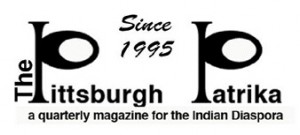By Kollengode S Venkataraman
e-mail:Â ThePatrika@aol.com
Sahana[1] is a 100% Pittsburgh-based music group with versatile traditional percussionists, guitarists, keyboardists, and also talented vocalists. A few of them are teenagers and one or two in their 40s, and others, in all ages in between, both men and women. Most of the adults are from India, with the teenagers born and raised here.
With full-time jobs in other fields, these people practice music in their free time for four to five months for their annual 2- to 3-hour long programs, usually in spring. The most interesting part of
Sahana’s program is that even with 100% of the artistes being “local,†their program is NOT free, as is the case with most programs in this town. They raise thousands of dollars selling tickets and seeking donations, and give away their net collections to a charity of their choice. This year, they had a talented teenager from India, Sai Vignesh Ramakrishnan, a Top-10 vocal finalist in the Super Singer Indian TV talent show, adding more luster.
 This year’s 6th fundraiser, held on May 31, Sunday at the Franklin Regional Middle School auditorium, exceeded their target of collecting $15,000 that Sahana gave to the Friends of the Pittsburgh Fisher House (FOPFH), an organization. FOPFH helps war veterans’ families with their boarding and lodging needs when they are in Pittsburgh for medical treatment. Mr. John Corder, a board member of the organization (see picture) addressed the gathering giving the stats on war veterans, their needs, and how FOPFH helps the veterans. Over the years, Sahana has donated over $60,000 to charities.
This year’s 6th fundraiser, held on May 31, Sunday at the Franklin Regional Middle School auditorium, exceeded their target of collecting $15,000 that Sahana gave to the Friends of the Pittsburgh Fisher House (FOPFH), an organization. FOPFH helps war veterans’ families with their boarding and lodging needs when they are in Pittsburgh for medical treatment. Mr. John Corder, a board member of the organization (see picture) addressed the gathering giving the stats on war veterans, their needs, and how FOPFH helps the veterans. Over the years, Sahana has donated over $60,000 to charities.
The highlights of this year’s 2-1/2-hour program:
- Over 20 musical pieces in Sanskrit, Tamil, Hindi, Urdu, Punjabi, and Gujarati; some of them very old (16th and 17th centuries).
- The songs chosen covered Tamil and Hindi/Urdu film classics made over five decades, and were interspersed and sequenced well.
- The emcees came well-prepared, delivered their tightly and tastefully written brief introductions for each piece, and quickly left the stage for the artistes. Refreshingly, nobody hogged the mike.
- The tuning of instruments in-between pieces — a bane in Indian pop music events — was kept to the barest minimum.
Overall, an enjoyable program.
Indian film songs describe different moods — joy, pathos, irreverence, sarcasm, humor, irony, paradoxes, and the dilemmas of life — often conveying great insights into life’s complexities. Some of the really good ones are as good as paid sessions with psychologists. So, lyrics are the heart, soul, spirit, and the very life of film songs, especially the good ones. (There are, of course, many bad ones, really tasteless and even obscene ones, I concede.) In this context, here are two observations from someone who bought the ticket and sat through the whole program.
- Leaving out the names of the lyricists who penned the masterpieces in printouts and announcements while mentioning the names of the films, music directors, and the singers who simply lend their voices (however mellifluous they are), is inelegant, to say the very least. Going forward, Sahana can correct this quite easily in their future programs.
- When the vocalists render their pieces, the phrases in the lyrics should come out loud and clear without getting drowned in the high-decibel music from instruments such as guitars and keyboards. When we carefully listen to Indian film songs in their original recordings, we can discern that when the vocalists render the pallavis/charanams (or mukhda/antaras), their voices come out clear in the front with the accompanying orchestra music’s volume in the background in low volume, relatively speaking. In the musical interlude between the pallavis and charanams (mukhdas and antaras), the vocalists are absent, and the orchestra music is at higher volume with great effect on the listening experience of the audience.
In the program the decibel level of the accompanying guitars and keyboards almost drowned out the vocalists in a few pieces. High decibel levels for the instruments during singing do not suit Indian film songs based on melody, where the lyrics are at the very center. Sahana can correct this by working with the professional sound engineers they hire.
Over all, it was a well-organized, well-rehearsed program with each member on-stage and off-stage working with passion and dedication.
[1]Â Sahana (pronounced sa-haa-naa), a common raga both in the Karnatic and Hindustani traditions, is the janya raga from the parent 22nd Melakarta raga Karaharapriya (Karnatic); and the progeny of the 10th Thaat Kafi (Hindustani). The Sahana music group has members coming from all over India.
Acknowledgments:Â Â Niveditha Vasudevan, Monroeville and Anandi Balakumar, Sewickley for the photographs.


